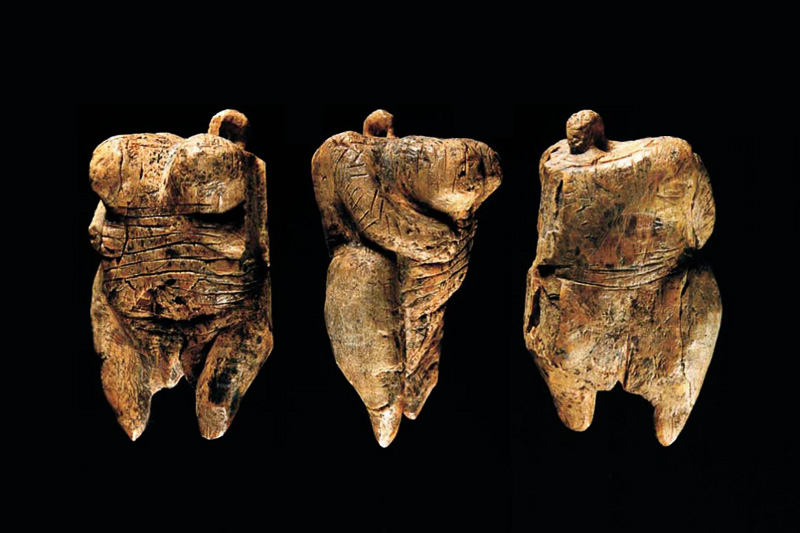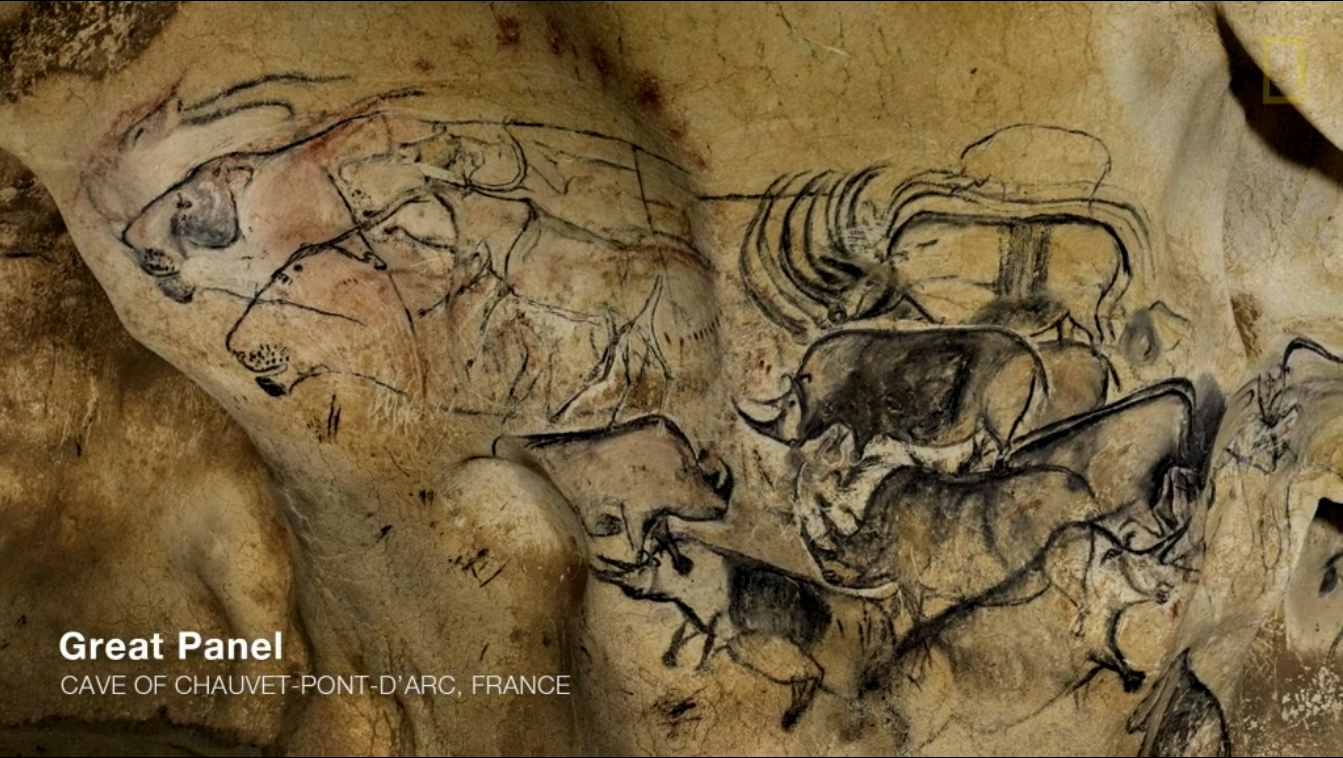Starting from the middle paleolithic going back to 100 thousand years Human intellect shows strong signs of complex behavior. Cognitive capacity were in place to track seasons, animal movements and resources spatially distributed over large areas.
Here you will find a concatenation of short clips compiled from scholarly resources such as the Nature Magazine, the British Museum, the Khan Academy, the Economist and the National Geographic all featuring great examples of art within the last 40,000 years. These include the masterpieces such as the Lion Man, the Venus of Willendorf and cave paintings from Europe as well as Indonesia.
The first two clips from the Nature Magazine and the British Museum are featuring a special exhibit at the British Museum in 2013 The Ice Age Art: Arrival of the Modern Mind.
The Löwenmensch figurine or Lion-man of the Hohlenstein-Stadel occupies a special place in early representations of Human creativity. It is a mammoth ivory sculpture dating back to between 35,000 and 40,000 years before present. It was discovered in a German cave in 1939 and it represents one of the earliest representations of figurative art. It is impressive in every aspect. Archeologists suspect that it took more than 400 hours to create it (see the Lion Man Experiment filmed by the Ulmer Museum in the playlist). It is a product of a fully modern mind with a busy working memory.
Another masterpiece of three dimensional figurative art during the ice age is The Swimming Reindeer. This permanent item of the British Museum depicts two reindeer swimming one behind the other who, 13,000 years ago, were roaming in great herds across Europe. The sculptor has used the narrowing shape of the mammoth tusk. The smaller, female reindeer is in front with the very tip of the tusk forming the tip of her nose. Immediately after her is the larger male, occupying the wider part of the tusk. The animals have their chins up and their antlers are tipped back in a swimming posture. Impressively, it is as if we have sonar vision and can see their submerged bodies. Their legs are at full stretch in a streamlined movement. A variety of line shading was used to show body contours, color and texture variation in the pelts of the reindeer. We can tell it is made by somebody who has spent a long time observing reindeer motions in various habitats including while swimming across rivers.
The male reindeer has a gorgeous set of antlers, extending at low angle towards his back. The artist clearly emphasized his masculinity by carving his genitals under his belly. The female has smaller antlers and four little bumps on her underside that resemble nipples. The animals appear to be in the autumn, since only during that time both male and female would have full sets of antlers. On the female’s chest, the ribs and the sternum have been beautifully carved. The anatomical knowledge surpasses that of a hunter. Our artist clearly has the know how of a butcher.
The playlist covers Venus figurines which are found widespread across Europe and near East. Venuses extend their influence all the way through the neolithic period as well such as the 6000 BC the Venus of Çatalhöyük. Here the Venus of Willendorf dating back to 25,000 years ago found in Austria is examined by the curators of the British Museum. Venuses discovered until now share a few prominent features, including extreme emphasis on sexual attributes and lack of emphasis on the head, face and arms and legs. In an ancestral ice age world when diet was high in nutrients but low in calories, exaggeration of body parts that emblemize the seemingly super-natural condition of abundant food intake must be a very desirable thought.
Since its relatively recent discovery in 2008 the Venus of Hohle Fels found in Germany expanded our representation art repertoire and extended our archeological depth in time as far back as 40,000 years to a period known as the Aurignacian. Before her discovery, it was generally thought that three-dimensional female depictions developed in the Gravettian. It is currently the oldest undisputed example of figurative art.
The Venus of Hohle Fels does not have a head. An off-centered, polished ring is located above her broad shoulders. The ring is an evidence that the figurine was used as a pendant. The right shoulder is elevated above the left side. Her large breasts project forwards. Hands with finger details carved at the ends of the two short arms rest on the upper part of the stomach below the breasts. The navel is visible and correctly placed anatomically. The Venus of Hohle Fels also is quite different from others with her widely spread legs. There are deeply incised horizontal lines covering the abdomen below the breasts to the pubic triangle. A few of these lines extend to the back of the figurine which could be representing clothing or an ornamental accessory. Microscopic analysis reveals that these incisions were created by cutting along the same lines recurring fashion into ivory with sharp tools.
The legs of the Venus are pointed and asymmetrical, with the left leg noticeably shorter. The buttocks and genitals are depicted in more detail. The split between the two halves of the buttocks is deep and continues without interruption to the front of the figurine, where the vulva with pronounced labia majora is exposed. Lines and markings on the surface add to the three dimensionality of the sculpture. There is no sign for pigment use.
The oldest and arguably the most controversial Venus is the Venus of Berekhat Ram found in Golan Heights of Israel. It is controversial because it was found sandwiched between two basaltic lava flows youngest layer is already 230,000 years old. If this is a hand made object, it must have been produced by Homo erectus.
Projecting an image onto a surface is a demonstration of theory of mind. Caves are fascinating locations where our prehistoric ancestors did such projections. As the archaeologists are expanding their search we are exposed more and more to the diversity of the artistic creations spanning from Europe to Sulawesi. Expansion of the search also detected some curious structures built by the Neanderthals in caves. Circular arrangements of stalactites and stalagmites deliberately broken to a certain size found inside Bruniquel cave in southwestern France by researchers in early 1990s excited everyone. These structures are more than 175,000 years old and show signs of controlled fire in certain parts.
Since the late 1980s it has been hypothesized that the sound within a cave may have influenced where our ancient ancestors drew or engraved their art. Accordingly, paintings should congregate in parts of the caves where the acoustic has particular qualities such as resonance, reverberation or a distinct echo. Musical instruments discovered so far including Hohle Fels flute 1 go as far back as 30,000 years therefore sound must have been an integral part of cave art. A rigorous scientific study to test this idea has been conducted in five prehistoric caves in Spain. Researchers have found that decorations were more likely to be found in areas with middling acoustics.
One of the most impressive art has been discovered in the Chauvet Cave of France. This location has been featured in the Werner Herzog documentary “The Cave of Forgotten Dreams”. Archeologists had a bitter experience in opening such caves to public. The Lascaux cave paintings has been sadly damaged beyond repair due to increased humidity. Happily we can take a virtual tour of the Chauvet cave with mesmerizing 360 degree zoomable view of almost every corner. Moreover, a replica of the entire cave has been built a few kilometers away from the original site using state of the art laser lidar technology. Perhaps the most fascinating feature of this 30,000 year old paintings is that the artists invented “motion picture” technique by depicting animals with multiple overlapping drawings. This is the time when representation art in the form of graphic and symbolic expression appears.
With every new discovery our boundary of knowledge about Human origins continue to expand. Genomic methods has already made a huge contribution to the Homo sapiens – Homo neanderthalensis interactions. It is a fascinating time to be alive. Watch this space!




0 Comments
You can be the first one to leave a comment.